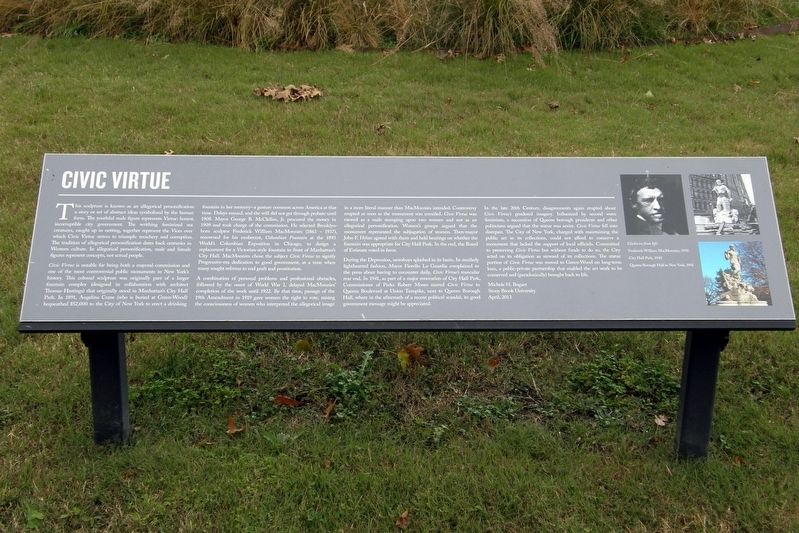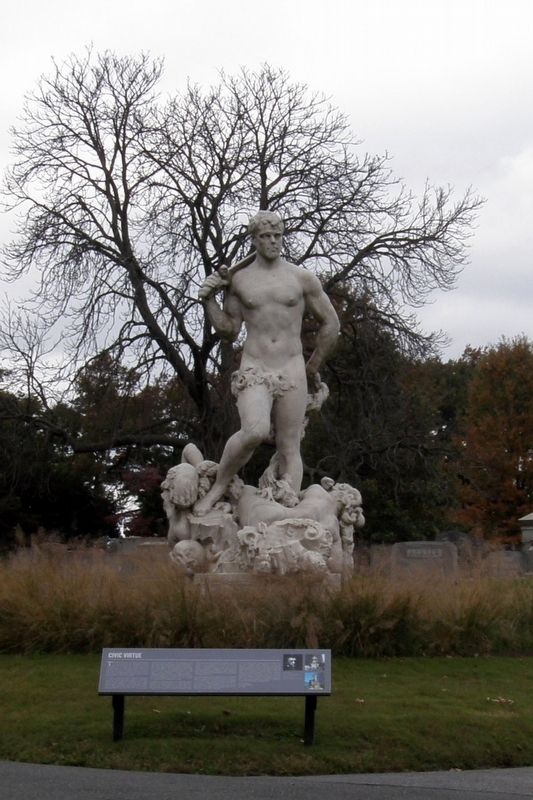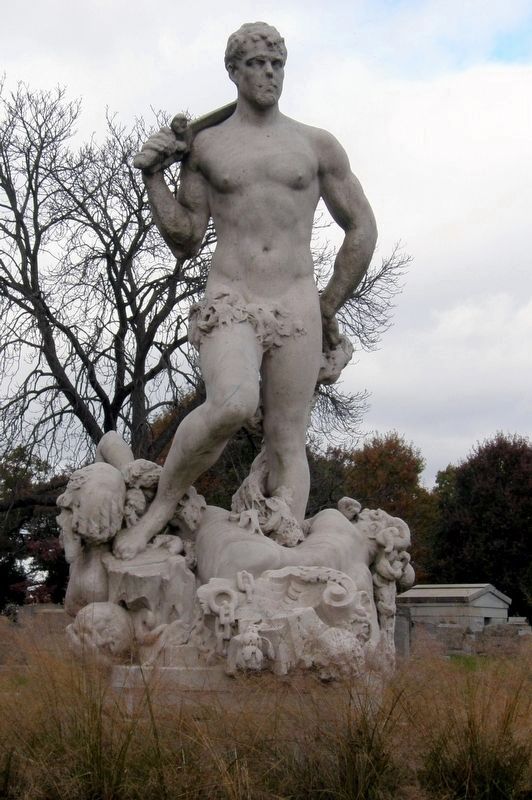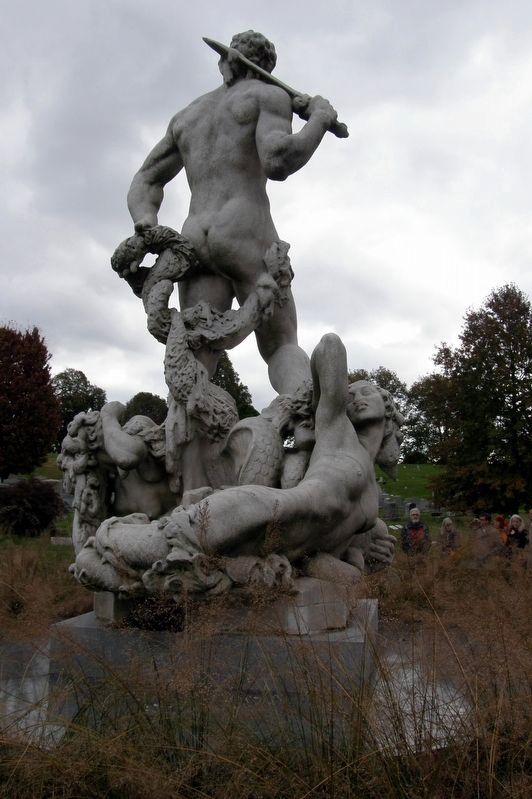Greenwood Heights in Brooklyn in Kings County, New York — The American Northeast (Mid-Atlantic)
"Civic Virtue"
This sculpture is known as an allegorical personification: a story or set of abstract ideas symbolized by the human form. The youthful male figure represents Virtue: honest, incorruptible city government. The writhing feminized sea creatures, caught up in netting, together represent the Vices over which Civic Virtue strives to triumph: treachery and corruption. The tradition of allegorical personification dates back centuries in Western culture. In allegorical personification, male and female figures represent concepts, not actual people.
Civic Virtue is notable for being both a mayoral commission and one of the most controversial public monuments in New York’s history. This colossal sculpture was originally part of a larger fountain complex (designed in collaboration with architect Thomas Hastings) that originally stood in Manhattan’s City Hall Park. in 1891, Angelina Crane (who is buried at Green-Wood) bequeathed $52,000 to the City of New York to erect a drinking fountain in her memory – a gesture common across America at that time. Delays ensued, and the will did not get through probate until 1908. Mayor George B. McClellan, Jr. procured the money in 1909 and took charge of the commission. he selected Brooklyn-born sculptor Frederick William MacMonnies (1863-1937), renowned for his exuberant Columbian Fountain at the 1893 World’s Columbia Exposition in Chicago, to design a replacement for a Victorian-style fountain in front of Manhattan’s City Hall. MacMonnies chose the subject Civic Virtue to signify Progressive-era dedication to good government, at a time when many sought reforms to end graft and prostitution.
A combination of personal problems and professional obstacles, followed by the onset of World War I, delayed MacMonnies’ completion of the work until 1922. By that time, passage of the 19th Amendment gave women the right to vote, raising the consciousness of women who interpreted the allegorical image in a more literal manner than MacMonnies intended. Controversy erupted as soon as the monument was unveiled. Civic Virtue was viewed as a male stomping upon two women and not as an allegorical personification. Women’s groups argued that the monument represented the subjugation of women. Then-mayor John F. Hylan agreed with them and held hearings on whether the statue was appropriate for City Hall Park. In the end, the Board of Estimate voted in favor.
During the Depression, newsboys splashed in its fountain. In similarly lighthearted fashion, Mayor Fiorello LaGuardia complained to the press about having to encounter daily, Civic Virtue’s muscular rear end. In 1941, as part of a major renovation of City Hall Park, Commissioner of Parks Robert Moses moved Civic Virtue to Queens Boulevard at Union Turnpike, next to Queens Borough Hall, where in the aftermath of a recent political scandal, its good government message might be appreciated.
In the late 20th Century, disagreements again erupted about Civic Virtue’s gendered imagery. Influenced by second wave feminism, a succession of Queens borough presidents and other politicians argued that the statue was sexist. Civic Virtue fell into disrepair. The City of New York, charged with maintaining the public art in its collections, could not afford to conserve a monument that lacked the support of public officials. Committed to conserving Civic Virtue but without the funds to do so, the City acted on its obligations as steward of its collections. The statue portion of Civic Virtue was moved to Green-Wood on long-term loan, a public-private partnership that enabled the art work to be conserved and (paradoxically) brought back to life.
Michele H. Bogart
Stony Brook University
April, 2013
Erected 2013.
Topics. This historical marker is listed in these topic lists: Arts, Letters, Music • Cemeteries & Burial Sites. A significant historical month for this entry is April 2013.
Location. 40° 39.388′ N, 73° 59.234′ W. Marker is in Brooklyn, New
York, in Kings County. It is in Greenwood Heights. Marker can be reached from Garland Avenue. The marker is on Garland Avenue within Green-Wood Cemetery. Touch for map. Marker is in this post office area: Brooklyn NY 11218, United States of America. Touch for directions.
Other nearby markers. At least 8 other markers are within walking distance of this marker. Altar to Liberty (about 700 feet away, measured in a direct line); Battle Hill (about 700 feet away); Huntington’s Regiment (about 700 feet away); Triumph on Battle Hill (about 700 feet away); Civil War Soldiers’ Monument (about 700 feet away); The Battle of Brooklyn (approx. 0.2 miles away); a different marker also named The Battle of Brooklyn (approx. 0.2 miles away); Our Drummer Boy (approx. 0.2 miles away). Touch for a list and map of all markers in Brooklyn.
Also see . . . "Civic Virtue". Wikipedia entry. (Submitted on April 17, 2020, by Larry Gertner of New York, New York.)
Credits. This page was last revised on January 31, 2023. It was originally submitted on December 3, 2018, by Larry Gertner of New York, New York. This page has been viewed 425 times since then and 34 times this year. Photos: 1, 2, 3, 4. submitted on December 3, 2018, by Larry Gertner of New York, New York. • Bill Pfingsten was the editor who published this page.



